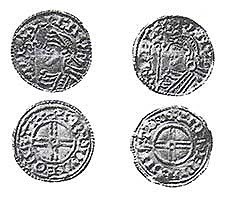
Steyning Museum archives: What did King Canute do for Steyning?
What indeed? Not much you might think. But it was during his reign, very nearly one thousand years ago, that he established the Steyning mint to make silver pennies in his image. It was an indication that Steyning was already a town of importance in this part of Sussex. There seems to have been a mint at Cissbury, possibly because it could be fortified against Viking raids, during the reign of Aethelred the Unready who died a few months before Canute won the throne, but no Cissbury coins have been found for later monarchs: maybe it was then safe to move the mint to Steyning.No silver pennies minted in Steyning during the few years following Canute’s death in 1035 until the accession of Edward the Confessor in 1042 have yet come to light. After that, however, Steyning coins from Edwards reign, from the ten months in which Harold II was in power and from the reigns of four Norman kings – William the Conqueror, William Rufus, Henry I and Stephen – have been identified. Then, during the conflict between Stephen and his cousin Matilda, known as the Anarchy, the mint was moved to Bramber Castle, presumably for reasons of security.
The men who made Steyning’s silver pennies, the ‘moneyers’, were always named on the back of the coins. So, we know that Canute’s coins were made here by Fredepine, that most of Edward’s and Harold’s coins were minted by Pulfric and Dermon and that the moneyer for William and his son had the slightly similar name of Diibern. We can even presume that the move of the mint to Bramber was a planned and peaceful one because Rodbert continued as the ‘moneyer’ for both mints. It was certainly in the interests of the ‘moneyer’ to toe the line and not make underweight coins – they were thin enough and light enough in the first place – because anyone caught doing so would have their hand cut off and nailed to the door of their workshop.
The location of Steyning’s mint is often thought to be The Stone House, opposite the junction between the High Street and Church Street. Maybe the reason for this belief is that the Stone House is so obviously old with thick stone walls, and because silver coins minted in Steyning were dug from a bank close by – just up Newham Lane. But this makes no sense and cannot be so.
In Canute’s reign there is no evidence that there was any settlement in that area; the geographical focus of the town, at that stage, being the Church. And the date attributed to the earliest part of the Stone House shows that its construction did not begin until some 300 years after the Steyning mint moved to Bramber. Where the mint was actually located we will probably never know.

